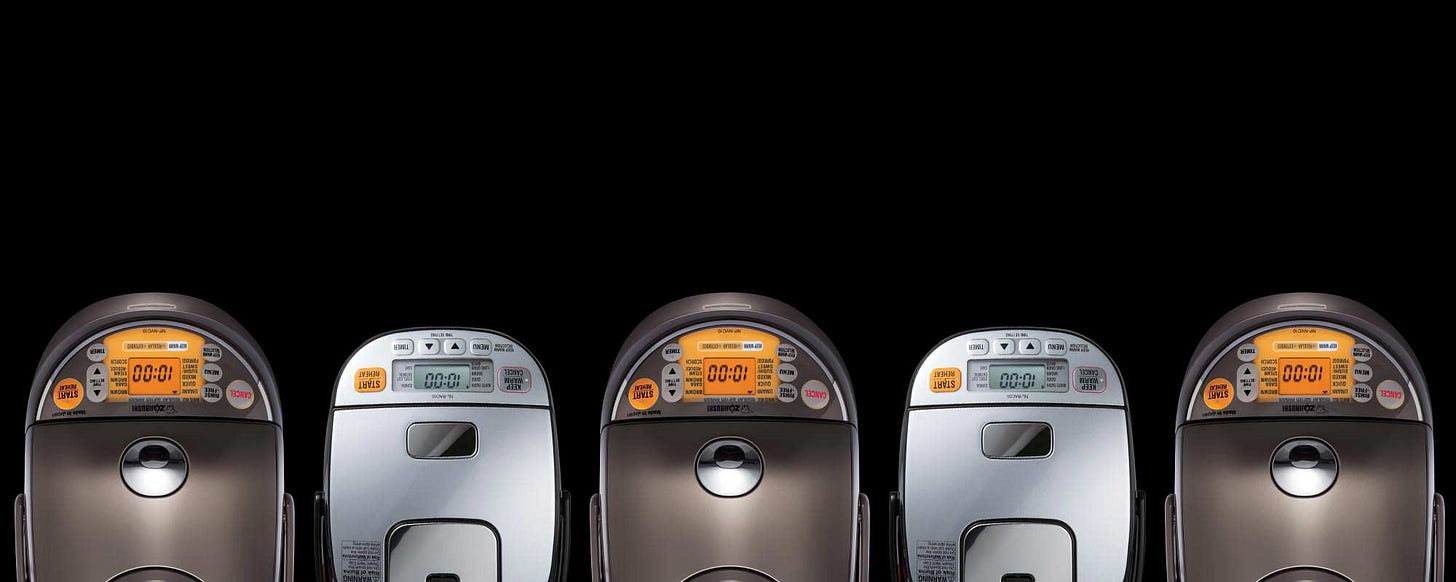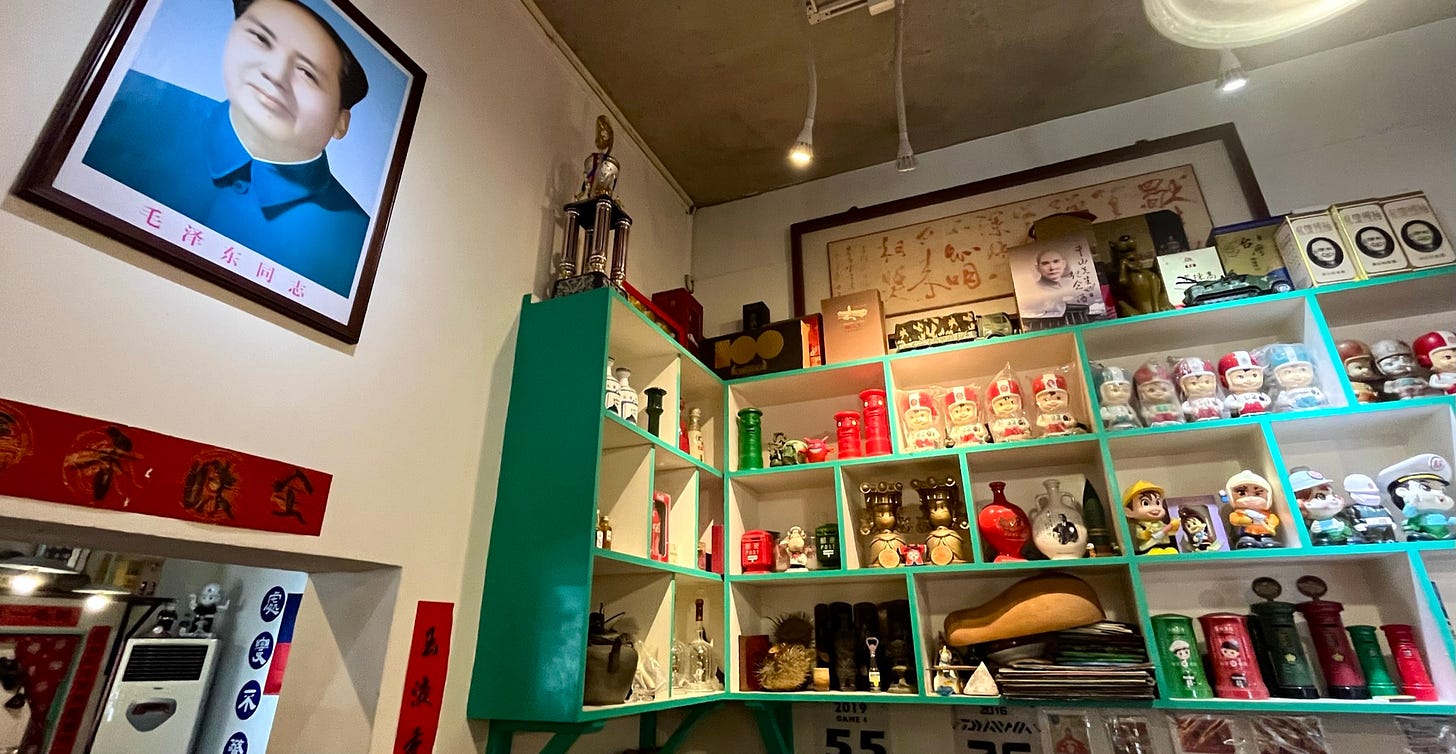If you ever happen to tune into any of the online debates about identity and belonging amongst members of the East Asian diaspora, a recurring theme that you will likely note is that of rice cookers. How many cups is the optimal capacity? Will I sacrifice the cooking quality of the rice if I get a multi-function rice cooker? Do I want electric pressure, pressure induction, micom, or fuzzy logic?
Perhaps unsurprisingly, although many of these conversations start off by focusing on the pros and cons of various technological options, they often rapidly evolve (devolve?) into debates over brands. The virtues of Zojirushi over Tiger, of Japanese versus Korean, of products made for domestic markets in Asia versus those produced for overseas markets. In these corporate head-to-heads, “my grandma’s rice cooker” (often purported to have been bought sometime during the Bronze Age) is a trump card offering up irrefutable proof of culinary preeminence.
In these debates, it often seems that the corporations that produce these rice cookers become metonyms for their respective nation. Zojirushi is Japan, Cuckoo is Korea. Here, Taiwan is no exception, with many overseas Taiwanese taking great pride in the rice cookers produced by Tatung 大同 (pronounced, through the vagaries of romanization, dah-tong). In short, rice cookers become the symbolic locus for imagined communities and the diasporic groups that look to them for their cultural roots.

Theres a reason I’m mulling over rice cookers this week, namely because my algorithmic overlords recently decided that I really needed to see a 2018 commercial celebrating Tatung’s 100th anniversary. And this has got me speculating wildly about brands, nationalism and, of course, music. So let’s jump in and see what we find!
Electric Aspirations of the Post-War Era
The post-War development of East Asia’s powerhouse technology companies is not a topic that is particularly within my comfort zone. Suffice it to say that, in the 1950s and 60s, consumer electronics products revolutionized the small routines of daily life in Asia just as surely as they did in countries like the United States.
In Taiwan, it was a home-grown company that came out on top in the contest for consumers’ trust and loyalty. Tatung was founded in Taipei in 1918, during the period of Japanese rule, and branched out into household electronics (particularly electric fans) in the period immediately following World War II. Over time, the company’s product portfolio grew to incorporate everything from fans and AC units to televisions and personal computers, with customers ranging from everyday consumers to the US military.
Nevertheless, in the words of Qin Xian Yu 秦先玉, the “Tatung Company is almost synonymous with [steam rice cookers] today” 大家很自然地把大同和電鍋畫上等號 (original Chinese article here.) Today, Tatung hovers somewhere between industrial megalith and cultural symbol, with the beloved mascot Tatung Boy 大同寶寶 a recurring visual trope throughout Taiwan, and with the company name stamped on a private high school and privately operated universities in Taipei and Chiayi. And although Taiwan’s silicon giants have long since crowded out Tatung on the list of Taiwan’s most profitable corporations, it was for a time Taiwan’s most valuable company. (Tatung’s fall from balance-sheet glory has certainly not been helped by a string of multi-billion-NTD scandals implicating the company’s founding family, leading Commonwealth Magazine 天下雜志 to declare, “Tatung was once the nation’s pride and joy … Now, it is a stain on the country’s image.”)

Without getting into technical details that I don’t understand, Tatung’s rice cookers work a little differently than most of those found in Japan, Korea, or the US. Most rice cookers that you see in the US, whether a $10 Black & Decker jobbie or a $250 Zojirushi, involve one pot. You add rice and water, and then insert the pot directly into the heating element. Tatung rice cookers work by having an inner and an outer pot. The inner pot is filled with rice and water, but water is also poured into the outer pot, creating steam heat. This means that the affordances of Tatung rice cookers are different from other brands—you probably can’t bake a loaf of bread in a Tatung (although, who knows, maybe you can), but you can steam full meals, or easily reheat leftovers. As such, in a pinch these versatile products become an all-in-one, alternately playing the role of rice cooker, stovetop, and microwave.
So … who cares, right? The thing is, Tatung’s rice cookers are part of a larger social phenomenon in which kitchen appliances become entangled with nostalgia for home, pride in national achievements, and historical insecurities about national development. In the sentimental short film that opened the Ministry of Culture’s national day celebrations (which I discussed in-depth a few weeks ago), statements like “This is where I learned the taste of home” are interspersed with cutaway shots meant to evoke home, including one of a rice cooker bubbling on a kitchen counter (at 00:54 in the video below).
Rice cookers and cooking appliances don’t just turn up in carefully orchestrated videos by the Ministry of Culture, they also turn up in commercially distributed films. In Wong Kar-Wai’s In the Mood for Love, Wong states that the whole story was inspired by the desire to
to say something about the rice cooker. Certain inventions in the 1960s changed the way we lived, and the rice cooker is one of them. In the film, our hero’s wife was a very capable writer and she wanted to work, but in those days, you have to stay at home and take care of the family and cook, which is very time-consuming. At the very beginning, he discovers the neighbor is a salesman selling these Japanese rice cookers, so he tries to get one for his wife, which allows her to work.1
Elsewhere, Tseng Chuang-hsiang’s 曾壯祥 short film “Vicki’s Hat” 小琪的那頂帽子, part of the Hou Hsiao-hsien omnibus film The Sandwich Man 兒子的大玩偶, the kitchen appliance theme moves laterally to pressure cookers, where a travelling salesman in Taiwan is killed by a faulty domestic product. On the one hand, kitchen appliances sell the dream of tasty, fresh dinners prepared in an instant, freeing caregivers (primarily women) from the kitchen. On the other hand, the kitchen appliance in this latter film serves as a proxy in the battle for technological dominance between Japanese mega-corporations and scrappy underdog Taiwanese companies.
The main takeaway, I hope, is that there is a long connection between nationalism and the consumer products at the heart of the banal routines of daily life. And here in Taiwan, Tatung practically is the rice cooker.
National Brand, Universal Earworm
So what about the video that sparked today’s post? Well, we’ll get there. But first, take a listen to a version of Tatung’s jingle from the 1960s:
Without translating the whole thing, the song opens with the line, “Tatung, Tatung good domestic products,” before proceeding to extol the quality of the various televisions, electric fans, washing machines and, yes, rice cookers sold by the company.
In many ways, the musical aesthetic of Taiwan’s flagship domestic company fits well with the kinds of music that were being taught in schools at the time. Public school music education at that time was called upon to increase “national spirit,” and relied heavily on military songs. Similarly, Tatung’s jingle’s textual appeal to national sentiment—“good domestic products!”—is couched in a martial musical idiom, starting with the slightly flatulent trumpet, and continuing through the steady percussion and four-square rhythms that suggest marching toward (commercial) victory. At the same time, the brash enthusiasm of the children’s singing is balanced out by the sweetness of the soloist in the second half of the jingle, bringing a veneer of sonic refinement to a recording that sometimes flirts with what comedienne Anna Russell might have referred to as musical “shock tactics.”
When talking to a couple of local friends about Tatung, both agreed that the song is one of those cultural referents that everyone in Taiwan just knows. Seeing as the song appears to have been around since at least the late 1960s, and possibly earlier, it’s not surprising that generations of Taiwanese would have associations not just with the company’s products, but also with the music.
These associations are reinforced by the omnipresence of Tatung signifiers in Taiwanese life. From the brightly lit corporate logo on the company’s headquarters visible from my apartment, to the mascot on the shelves of blue nostalgia restaurants, and the shade of green-ish blue that adorns the façade of some blue nostalgia restaurants, Tatung pervades much of the fabric of daily life. Tatung Boy even shows up at baseball games to get the crowd going (although, to be fair, if this video is anything to go on, the success rate of this move is unclear.)
One of the things that’s interesting to me, besides the fact that Tatung Boy seems to be fighting an uphill battle for the crowd’s attention (even in triplicate) is the consistency of the theme tune that accompanies his entrance. Even almost 50 years after the first recording, and even in a baseball stadium, the mascot’s entrance is still accompanied by the strident children’s choir and martial underscoring of the original.
That consistency makes the video that originally caught my attention even more striking:
There’s a lot going on in this video. Far more, in fact, than I currently have time to unpack. But we can at least cover a few of the more salient points.
First there are the visual components. The rapid cuts between different scenes of would-be stop motion animation, the bright colors evoking a retro 1960s vibe, the pervasiveness of fans, and even an explicit call-out to “Tatung green” at 00:30 suggest that this 100th anniversary video is still an advertisement, but that nakedly capitalist product-pushing is combined here with a playful wink and nudge toward the company’s own history. At the heart of much of this imagery is the rice cooker, playing roles ranging from magic hat out of which the animators pull their scenes, to smiling character with a push-button nose.
Elsewhere, this paean to Tatung’s industrial might combines retro images with markers of modernity: the old box television becomes an accessory for a dancing, baseball-cap-wearing youth crowd at 00:22; the rolodex of rice cookers and Tatung Boy at 00:58 give rise to claymation-style TVs, fans, and AC units in the sleek whites and blacks of a post-Steve Jobs world; the brightly colored brick-and-wood house at 1:05 holds a wifi-connected phone in its chimney-hand; and at 00:56, the lead singer demands, “What about the future?”
Perhaps most obvious, though, is the hip-hop based musical aesthetic underpinning the entire production. The main vocal line, under which the four-square snare drums of the original jingle are replaced by four-square drum machines, still sings the virtues of Tatung’s product line, but does so by drawing on a globalized musical aesthetic that is in many ways the antithesis of the “good music” promoted by the state in mid-century Taiwanese classrooms.
The affordances of hip-hop, however, mean that even this video is not a complete abandonment of 60-plus years of jingling tradition. When melodic content enters at 00:41, it samples the original melody heard in the 1968 video, although now livened up with catchy syncopations. Thus, there is still something here to appeal to those pining for the good old days of cutely militarized children singers and the nostalgia of veteran rice cookers sitting on a grandparent’s kitchen counter.
Brand-name Nationalism
As I said at the beginning of this post, it often seems that the debates over rice cookers function as stand-ins for questions of national and cultural identity. Just as images of food, cooking, and family meals are tropes of the nuclear family in Sinophone film and television, the abstracted rice cooker becomes a metonym for the imagined merits and demerits, flaws and ingenuities of its nation of origin.
One of the reasons that food is such an effective trope in film and television is that it summons up emotional responses: the fun and fights at the family dinner table, the smells of a baking pie remembered from childhood, the taste of a parent’s signature mac and cheese or sanbeiji 三杯鷄. The emotions called up by memories of food and the communities that form around it evade logical interrogation—i.e., “if I feel it, it must be true.”
Music functions in a similar way, summoning emotional responses while evading deeper consideration at the level of logic. But music also “sticks” to images and ideas, even when music and image have no intrinsic connection. It’s impossible to hear a particular celesta motif without thinking of Hogwarts; it’s difficult not to associate a certain four-note sequence with Intel; and no one will ever take YMCA away from the gay community.

Advertisement works in similar ways, using a variety of cultural referents, including music, to form positive associations with products, thereby eliciting desire in consumers. And when that brand is itself a national symbol, advertising exists in a complex alchemical environment drawing on brand, nation, image, and music.
What’s interesting to me is the stark reinvention that happens in Tatung’s 100th anniversary video. Where the manically peppy military marches of the 1960s were a distinctly local phenomenon, Tatung’s aural identity of the late 2010s draws on a global hip-hop vernacular. In turn, this points us toward a company (or at least an advertising department) with very different vision of what makes Taiwan Taiwan. In the earlier advertisement, government-prescribed military aesthetics suggest a connection between buying domestic and the self-strengthening imperatives of Taiwan’s KMT era. 100 years into Tatung’s history, the highly produced advertisement seems to address a cosmopolitan, culturally savvy Taiwanese consumer who may be willing to partake in a little bit of nostalgia, but not at the expense of the markers of modernity.
Is Tatung reinventing Taiwan’s national image? Probably not. I’m more inclined to believe that their gaggle of advertising executives is responding to perceived changes in their consumer base. And, of course, there’s nothing to say that they got it right. But, if in doubt, it might be an interesting topic to debate over dinner.
Wong Kar Wai, quoted in Joe McGovern, “Wong Kar Wai was in the mood for conversation at MOMA book chat,” https://ew.com/article/2016/05/24/wong-kar-wai-moma/. Accessed 28 November 2022.



